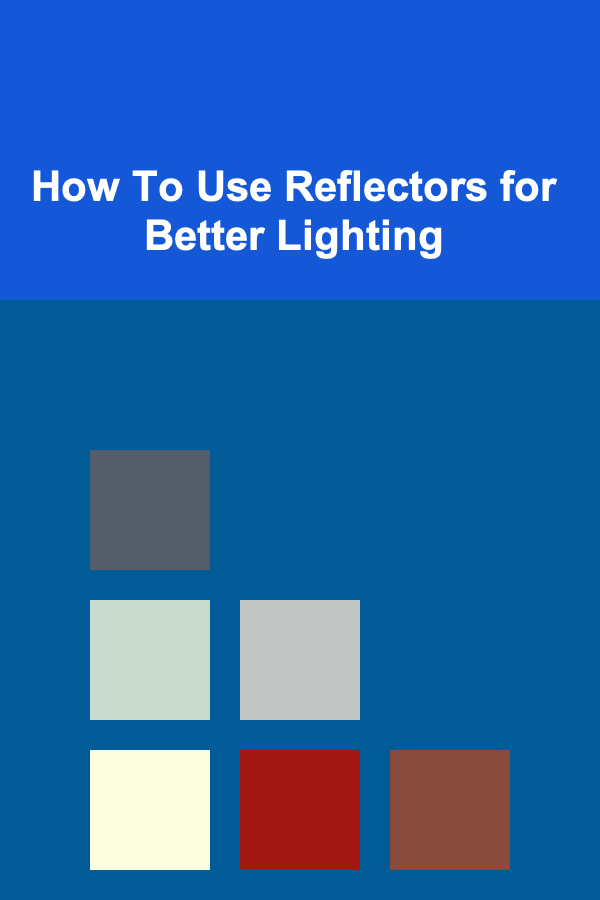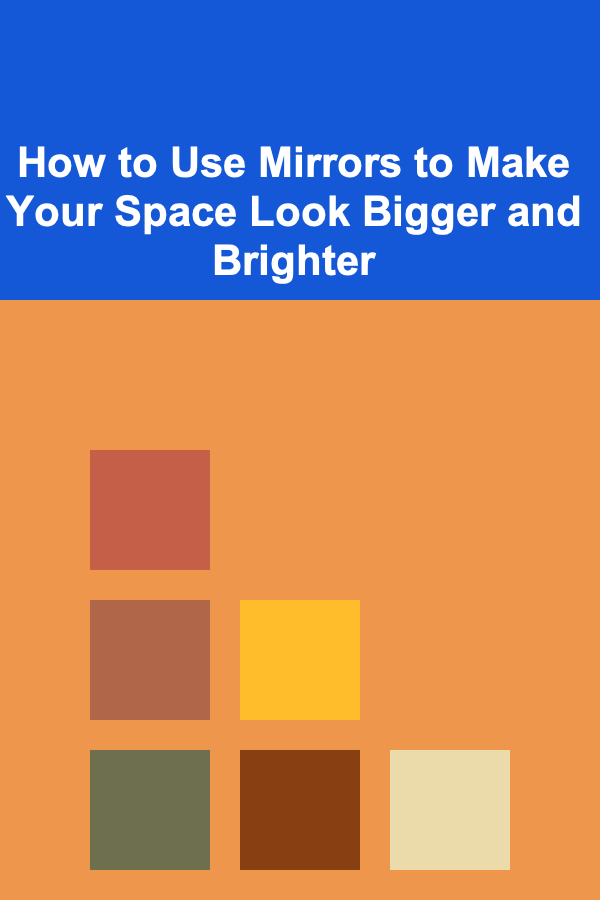
How To Use Reflectors for Better Lighting
ebook include PDF & Audio bundle (Micro Guide)
$12.99$9.99
Limited Time Offer! Order within the next:

Lighting plays a crucial role in photography, videography, and even in everyday life. It enhances the quality of images, sets the mood of a scene, and brings out the finer details. While most photographers and videographers focus on lighting from artificial or natural light sources, one tool that often gets overlooked is the reflector. Reflectors are simple yet effective tools that can improve your lighting setup without needing expensive equipment. This article explores how to use reflectors for better lighting, from understanding their basics to practical applications in different settings.
What is a Reflector?
A reflector is a simple tool used to bounce light onto a subject, usually to fill in shadows or enhance highlights. Reflectors are available in various sizes and materials, but all share a common function: to redirect light. Reflectors come in handy in a variety of settings, whether you're shooting indoors or outdoors. The light they bounce can come from the sun, artificial light sources, or even ambient light.
Reflectors are typically made from materials like white, silver, gold, and translucent fabric, each offering different qualities of light. Understanding the characteristics of these materials will allow you to choose the right one for your particular lighting needs.
Types of Reflectors
Reflectors come in a range of sizes and finishes, and each type of reflector serves a unique purpose in lighting setups. Let's break down the most common types of reflectors and their uses.
1. White Reflector
The white reflector is one of the most commonly used types. It provides a soft, even fill light that works well in many situations. White reflectors diffuse light gently and help reduce harsh shadows without drastically altering the color of the light. This type of reflector is particularly useful in portrait photography, where you want the light to appear natural and flattering without introducing any harsh contrasts.
- Best for: Portrait photography, product photography, and other setups where a soft fill light is required.
2. Silver Reflector
A silver reflector offers a much stronger, more intense bounce of light compared to the white reflector. It enhances highlights and provides a cooler, more contrasty fill. Silver reflectors are excellent for situations where you need a more dramatic lighting effect or want to emphasize the texture of a subject.
- Best for: High-contrast photography, fashion shoots, and situations where you need brighter, more intense lighting.
3. Gold Reflector
Gold reflectors are used when you want to add warmth to the lighting. This can be especially useful in portrait photography when you're aiming for a sun-kissed, warm, or golden-hour effect. The golden tint helps introduce a rich, warm glow to the subject, which can be especially flattering for skin tones.
- Best for: Portraits, beauty shots, and any situation where a warm, golden glow is desired.
4. Translucent Reflector
A translucent reflector is designed to diffuse light. It's often used when you need to soften the light from a harsh light source. It's commonly placed between the light source and the subject to create a more even, gentle lighting effect, especially when shooting in direct sunlight or using a strong artificial light source.
- Best for: Softening the light in high-contrast environments or reducing harsh sunlight.
5. Black Reflector
While black reflectors are not used for reflecting light in the traditional sense, they can be used to block light or create shadows. By absorbing light rather than bouncing it back, black reflectors can be used to control light, reduce spill, or even create dramatic shadows in a scene.
- Best for: Reducing light spill, controlling shadows, and creating contrast in your lighting.
How to Use Reflectors for Better Lighting
Now that you understand the types of reflectors, it's time to delve into how to use them effectively in different lighting situations. Reflectors can be used in a variety of ways to control the direction, intensity, and quality of light. Let's explore some practical applications for reflectors across different fields.
1. In Portrait Photography
One of the most common uses of reflectors is in portrait photography. Whether you're shooting indoors or outdoors, reflectors can be used to soften shadows, brighten facial features, and even out light distribution. Here's how you can use reflectors to enhance your portrait shots:
- Fill Shadows: Often, the light source will create shadows on the face, especially under the chin, eyes, or nose. A reflector can bounce light back into those shadows, providing a fill that softens the harsh lines.
- Balance Light: If you're shooting outdoors in natural light, you might encounter situations where the subject is partially in the sun and partially in the shade. A reflector can help bounce light from the brighter areas to fill in the shadowed regions, ensuring your subject is evenly lit.
- Enhance Highlights: Silver and gold reflectors are great for enhancing highlights in the eyes, hair, or other reflective parts of the subject. A silver reflector, for instance, can make the eyes sparkle, while a gold reflector can add a warm, glowing highlight to the skin.
2. In Product Photography
For product photography, reflectors are invaluable for ensuring that every part of the product is well lit. Here's how reflectors can help:
- Fill Light: Often, product photos need to highlight every aspect of an item, including the fine details that might be lost in shadows. A white or silver reflector placed opposite the main light source can fill in any dark spots.
- Add Contrast: Sometimes, adding contrast can help emphasize the texture of a product, especially in items like jewelry, watches, or food. A silver reflector can provide a high contrast fill, enhancing the details and giving a sense of depth to the image.
- Highlight Specific Areas: If you need to draw attention to a particular detail on the product, you can use a reflector to create highlights in that area. Gold reflectors are especially good for giving products a rich, appealing shine.
3. In Video Production
In video production, lighting is essential to ensure your subjects are clearly visible and look natural on camera. Reflectors can help with several aspects of video lighting:
- Fill Light for Interviews: When shooting interviews, a reflector can fill in the shadows cast by the key light, especially if the subject is sitting or standing in front of a window or under overhead lights. This ensures the subject's face is well-lit and avoids the look of "raccoon eyes."
- Creating Mood: Reflectors are often used to shape the mood of a video scene. For example, if you want a high-contrast look, a silver reflector can add a dramatic, cool-toned fill. For a warm, welcoming look, a gold reflector will add a cozy, golden glow.
- Reflecting Natural Light: When filming outdoors, a reflector can be a game-changer in making sure natural sunlight is being utilized to its fullest potential. Reflectors can help bounce light onto the subject, particularly during times when sunlight is coming from harsh angles or casting shadows.
4. In Fashion Photography
Fashion photography often requires precise control over light to create the desired visual effect. Reflectors play a key role in this:
- Bouncing Light onto the Model: Reflectors help add additional light onto a model, ensuring that their entire outfit is evenly lit. For example, when shooting a model against a dark background, a reflector can help ensure the subject doesn't get lost in the shadows.
- Creating a Balanced Look: Silver and white reflectors can fill in the shadows on the model's body, making sure there are no deep shadows that detract from the clothing. This is particularly important in fashion photography, where every detail of the clothing needs to be visible.
- Enhancing Textures: Reflectors can be used to highlight the texture of fabrics, making the clothing appear more dynamic and visually interesting. Gold reflectors can add a subtle sheen to fabric, giving it a luxurious look.
5. In Outdoor Photography
When shooting outdoors, reflectors can be used in a variety of ways to manipulate natural light. The sun can be harsh, creating uneven lighting or deep shadows, and a reflector can help manage this.
- Fill Shadows on Faces: When shooting portraits outdoors, especially during midday when the sun is high, reflectors can be used to bounce sunlight back into the face, reducing shadows around the eyes and under the chin.
- Control Contrast: If you want to reduce the harsh contrast between light and shadow, a translucent reflector can be placed between the subject and the sun, diffusing the light and softening the overall scene.
- Create Catchlights in Eyes: A silver or white reflector can be positioned near the subject's face to create small reflections in the eyes, often referred to as catchlights. This adds life and vibrancy to the portrait.
Conclusion
Reflectors are simple but powerful tools that can drastically improve the quality of your lighting, whether you're shooting portraits, products, fashion, or video. By understanding the different types of reflectors and how to use them effectively, you can shape your light, reduce unwanted shadows, and add highlights or warmth to your subject. In addition to their versatility, reflectors are cost-effective tools that can help you achieve professional results without the need for expensive lighting equipment. Experiment with different materials, sizes, and placements to find the best reflector techniques for your photography or videography needs. Reflectors are, without a doubt, an essential tool in the lighting toolkit of any creative professional.
Reading More From Our Other Websites
- [Home Budget 101] How to Negotiate Bills and Save Money on Monthly Expenses
- [Scrapbooking Tip 101] DIY Sticker Hacks: Turning Everyday Items into Custom Scrapbooking Accents
- [Home Party Planning 101] How to Use Party Planning Apps to Stress Less and Enjoy Your Own Party More
- [Home Cleaning 101] How to Keep Your House Clean in a Busy Household
- [Personal Care Tips 101] How to Apply Eye Cream for Maximum Benefits
- [Organization Tip 101] How to Reflect on Your Moving Experience for Future Moves
- [Personal Investment 101] Best Real Estate Investment Strategies for Beginners: A Step‑by‑Step Guide
- [Biking 101] Top 5 Benefits of Tubeless Tires for Cyclists
- [Personal Investment 101] How to Invest in Renewable Energy Projects
- [Organization Tip 101] How to Organize Your Kitchen Inventory for Meal Prep

How to Analyze Market Trends and Consumer Behavior for Strategic Decisions
Read More
How to Create a Job Interview Checklist for Practicing Common Interview Questions
Read More
How to Use Mirrors to Make Your Space Look Bigger and Brighter
Read More
How to Use Paint to Refresh Your Home Decor Without Breaking the Bank
Read More
How to Meal Plan for Athletes: Fueling Performance
Read More
10 Tips for Using Project Management Software for Beginners
Read MoreOther Products

How to Analyze Market Trends and Consumer Behavior for Strategic Decisions
Read More
How to Create a Job Interview Checklist for Practicing Common Interview Questions
Read More
How to Use Mirrors to Make Your Space Look Bigger and Brighter
Read More
How to Use Paint to Refresh Your Home Decor Without Breaking the Bank
Read More
How to Meal Plan for Athletes: Fueling Performance
Read More